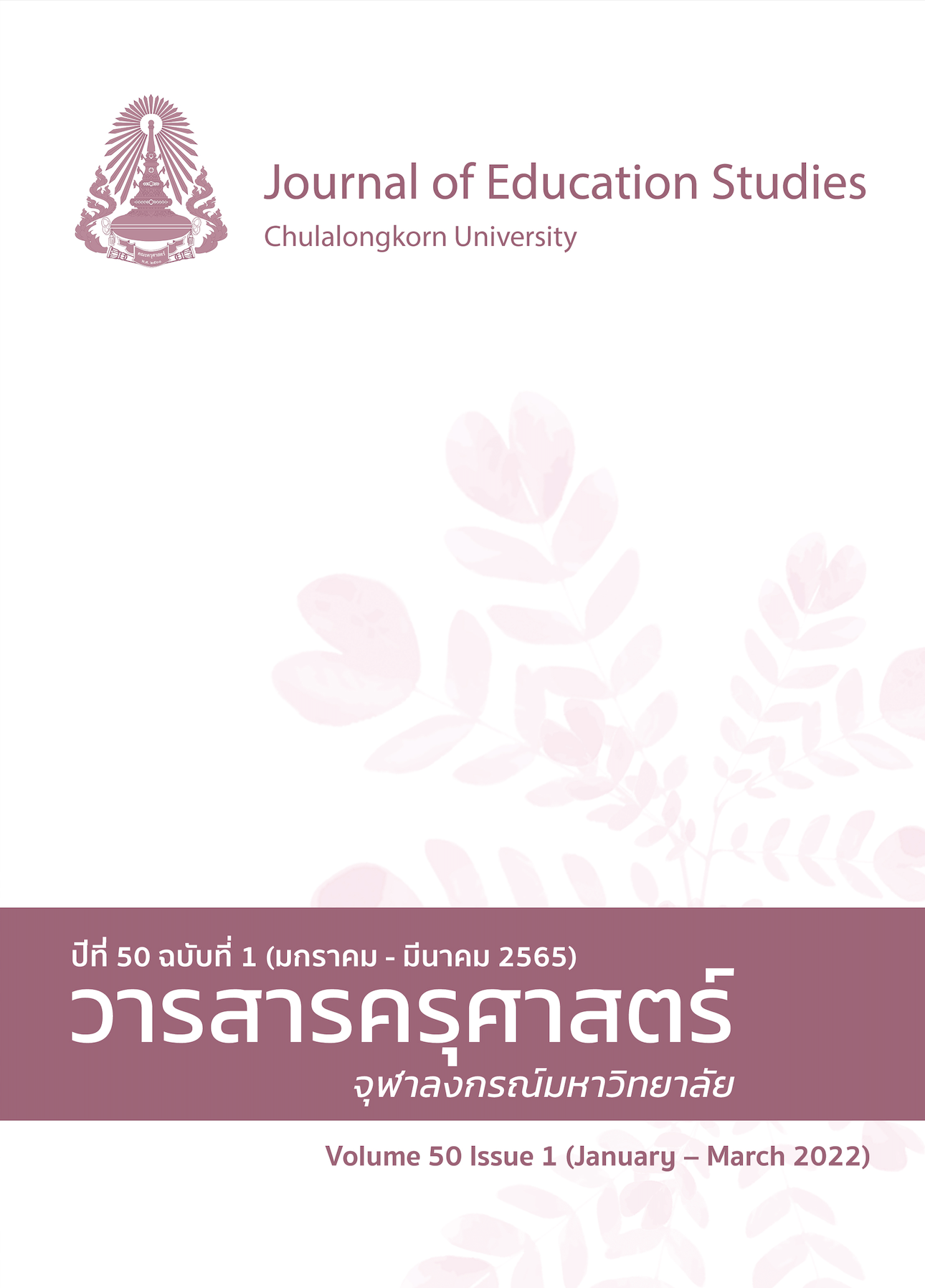Development of Art Activities to Create Aesthetic Experiences for Visually Impaired Elementary Students
DOI:
https://doi.org/10.14456/educu.2022.3Keywords:
art activities, aesthetic experience, elementary students with visual impairmentAbstract
This work aims to study and develop various art activities to help create aesthetic experiences for elementary students with visual impairment. The objectives of this research are two-fold: 1) to investigate the guidelines for the development of art activities that can help create aesthetic experiences for visually impaired elementary students, and 2) to develop art activities to foster such experiences for these students. Data were collected through a review of literature and interviews with experts in this field. Then, data analysis was conducted using content analysis. The results of this study reveal that the guidelines for the development of art activities to create aesthetic experiences for visually impaired elementary students consists of four areas: sensory, teaching methods, media and materials, and evaluation. Furthermore, art activities that can help create such experiences for these students consist of four lessons: smearing the art on cave walls, tales from leaves, drawing lines with emotions playing, and creating Picasso-style faces. These activities can create of aesthetic experiences, perceptions of beauty from reality, and expressions of thoughts and feelings through art.
References
ภาษาไทย
กระทรวงศึกษาธิการ. (2552). ประกาศกระทรวงศึกษาธิการ เรื่อง กำหนดประเภทและหลักเกณฑ์ของคนพิการทางการศึกษา พ.ศ. 2552. http://www.mua.go.th/users/he-commission/doc/law/ministry%20law/1-42%20handicap%20MoE.pdf
กระทรวงศึกษาธิการ. (2560). หลักสูตรการศึกษาปฐมวัย พุทธศักราช 2560. กระทรวงศึกษาธิการ. http://academic.obec.go.th/images/document/1515232879_d_1.pdf
กำจร สุนพงษ์ศรี. (2559). สุนทรียศาสตร์ : หลักปรัชญา ทฤษฎีทัศนศิลป์ ศิลปะวิจารณ์ (พิมพ์ครั้งที่ 3). สำนักพิมพ์แห่งจุฬาลงกรณ์มหาวิทยาลัย.
ไชยเดช แก้วสง่า. (2556). เข้าใจสุนทรียศาสตร์ เข้าถึงคุณค่าความงามศิลปะ. วารสารศึกษาศาสตร์ ฉบับวิจัยบัณฑิตศึกษา, 7(3), 1-8.
ทักษิณา พิพิธกุล. (2559). สุนทรียศาสตร์กับศิลปะ : จากการเสนอภาพตัวแทนถึงสุนทรียะเชิงสัมพันธ์. สถาบันวัฒนธรรมและศิลปะ, 17(2), 18-24.
ปริญญา ชาวสมุน. (2562). เรียนศิลปะด้วยฝ่ามือ. http://www.judprakai.com/life/835
พิเชษฐ์ เปียร์กลิ่น. (2552). การวิเคราะห์รูปแบบในงานศิลปะ และบุคลิกลักษณะ (Style) ของศิลปิน. RUSAMILAE JOURNAL, 30(3), 87-95. https://so05.tci-thaijo.org/index.php/rusamelae/article/view/70868
ยุพา มหามาตร. (2559). จากความมืดมนสู่แสงสว่างในมือเรา: การสร้างกระบวนการทางศิลปะกับจิตวิทยาเพื่อกระตุ้นและสนับสนุนการแสดงออกอย่างอิสระของเด็กผู้พิการทางสายตา. วารสารวิจิตรศิลป์, 7(2), 49-116.
โรงเรียนสอนคนตาบอดกรุงเทพ. (ม.ป.ป.). กิจกรรมการปั้น เสริมสร้างจินตนาการ. http://www.blind.or.th/centre/intoProduct/1/?id=77
ภาษาอังกฤษ
Feeney, D. (2007). Toward an aesthetic of blindness: An interdisciplinary response to Synge, Yeat, and Friel. (Vol. 38). Peter Lang.
Isik. (2016). The impact of storytelling on young ages. European Journal of Language and Literature Studies, 2(3), 115-118. http://journals.euser.org/files/articles/ejls_sep_dec_16/muhammed.pdf?fbclid=IwAR3GMdIRldl8qUXiNH0l-kVOO-PbUbxhyjN8hVQOP4VD8ggfpAnGs6AT2q4
Kuo, M., Barnes, M., & Jordan, C. (2019). Do experiences with nature promote learning? converging evidence of a cause-and-effect relationship [Mini Review]. Frontiers in Psychology, 10(305). https://doi.org/10.3389/fpsyg.2019.00305
Lopes, A. (2015). Aesthetics, aesthetic theories https://www.researchgate.net/publication/283348334_Aesthetics_Aesthetic_Theories/citations
Mjallegra. (2012). Expressing emotions through color and line. https://art-engine.org/2012/02/26/expressing-emotions-through-color-and- line/?fbclid=IwAR23v6WpZPM5ZfUKVsOK_iPWtXTuT53NZQCbot9WIrd9Gm8pI8skW_wB08
Phyl. (2010). Into the caves! by 4th grade https://plbrown.blogspot.com/2010/05/into-caves-by-4th-grade.html?fbclid=IwAR3s4BkVf1hH7oWeVVcMlr3LP7CMTFfB_T_wU3TBZFdAs33s-djb-25rWRA
Play Ideas. (2021). 25 Picasso inspired art projects for kids. https://www.playideas.com/25-picasso-inspired-art-projects-forkids/?fbclid=IwAR1fNplRw9pYIqfiVpfJ_qiwK4uFdeXeC_Fo2WFD5XofmgtPjEp3YMuNLFE
Poole, J. (1992). Age related changes in sensory system dynamics related to balance. Physical & Occupational Therapy In Geriatrics, 10(2), 55-66. https://doi.org/10.1080/J148v10n02_04
Royal Society of Chemistry. (2021). Analysis of cave paintings. https://edu.rsc.org/resources/analysis-of-cave-paintings/1586.article?fbclid=IwAR3LsyfKwWNanFzuZwdBwcJegGDPKloexGP3Vs1QEihl0tKSIJT39RUJBU
Szubielska, M., Pasternak, K., Wójtowicz, M., and Szymannska, A. (2018). Evaluation of art of visually impaired people by children and adults. https://www.researchgate.net/publication/330422916
Wiltshir, C. (2014). Michael J. Parsons. https://prezi.com/vrtxmroeusao/michael-j-parsons/
Downloads
Published
How to Cite
Issue
Section
License

This work is licensed under a Creative Commons Attribution-NonCommercial-NoDerivatives 4.0 International License.




